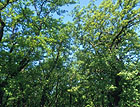New disease could fell British oaks
Acute Oak Decline has the potential to wipe out both English and Sessile oaks, say campaigners


Landowners and woodland groups are calling on the new Government to take action to save the native oak tree from a condition that may prove as catastrophic as Dutch elm disease. They say the spread of Acute Oak Decline (AOD) has the potential to wipe out both the English and Sessile oaks and are lobbying Defra to take the threat seriously. ‘Our native, iconic English oak is doomed unless we can come up with something fast,' says Peter Goodwin of Woodland Heritage.
At Chelsea, RHS president Giles Coode-Adams warned: ‘We are becoming overrun with new and lethal pests and, alas, governments around the world are cutting back on horticultural research.' Although AOD has probably been present in the UK since the mid 1990s, its seriousness was only realised in 2008. Most likely caused by a bacterial infection, it has since been confirmed on 55 sites in the east and south of England and the Midlands, although the true figure is believed to be much higher as so little is known about the disease.
The Duke of Bedford has joined the campaign for £10 million to be spent over the next five years on research into tree diseases. ‘We started noticing big problems with the oaks here at Woburn Abbey about five or six years ago, and, since then, have lost 30 to 60 trees a year,' he confirms. The Woodland Trust is equally alarmed. ‘It has all the characteristics of Dutch elm disease and could have horrific consequences,' says the charity's Paul Hetherington. ‘We know what's killing the trees, but not what causes it or how it spreads.'
The Forestry Commission recently issued new advice for landowners and revealed that scientists at Forest Research, its research arm, have made some headway. ‘We strongly suspect that it is being caused by a complex interplay of a number of factors, of which we expect bacteria to be a key one,' says senior pathologist Dr Sandra Denman. ‘We've identified one species of previously unknown bacterium, which appears to be playing a part. We've also found evidence that buprestid beetles, which typically attack oak trees that are in decline, are playing a part, perhaps by spreading the bacteria, but again, we don't yet know for sure. We need to carry out more research.'
Repelling the bug invaders
* AOD causes dark fluid to bleed from trunks and stems, followed by rapid die-back and death, and can kill a tree in four or five years.
* AOD should not be confused with Sudden Oak Death (SOD), a term used in North America. SOD is present in Britain, but has mostly affected shrubs such as rhododendrons and Japanese larch trees in the West Country.
Exquisite houses, the beauty of Nature, and how to get the most from your life, straight to your inbox.
* The Woodland Trust is asking the public to report suspected cases of AOD to Forestry Research (01420 22255; www.forestresearch.gov.uk). It also recommends saving acorns for replanting.
* Since Dutch elm disease re-entered the UK in 1967, more than 25 million English elms have been destroyed.
* The EU has banned the import of maple trees from China to prevent the spread of the citrus longhorned beetle.
* The Forestry Commission is inspecting ash trees for the devastating Asian bug emerald ash borer (EAB), which was discovered in Moscow recently, and British ports are imposing controls.
* For more country news like this every week, subscribe and save
An experienced journalist, Paula Minchin, Country Life's Managing & Features Editor, has worked for the magazine for 10 years — during which time she’s overseen two special issues guest-edited by His Majesty The King in 2013 and in 2018, and the bestselling 2022 edition masterminded by his wife, Queen Camilla. A gamekeeper’s daughter, Paula began her career as a crime reporter on The Sidmouth Herald in Devon, before becoming Pony Club & Young Rider Editor, then Racing Editor, at Horse & Hound. Paula lives in Somerset with her two working Labradors, Nimrod and Rocky.
